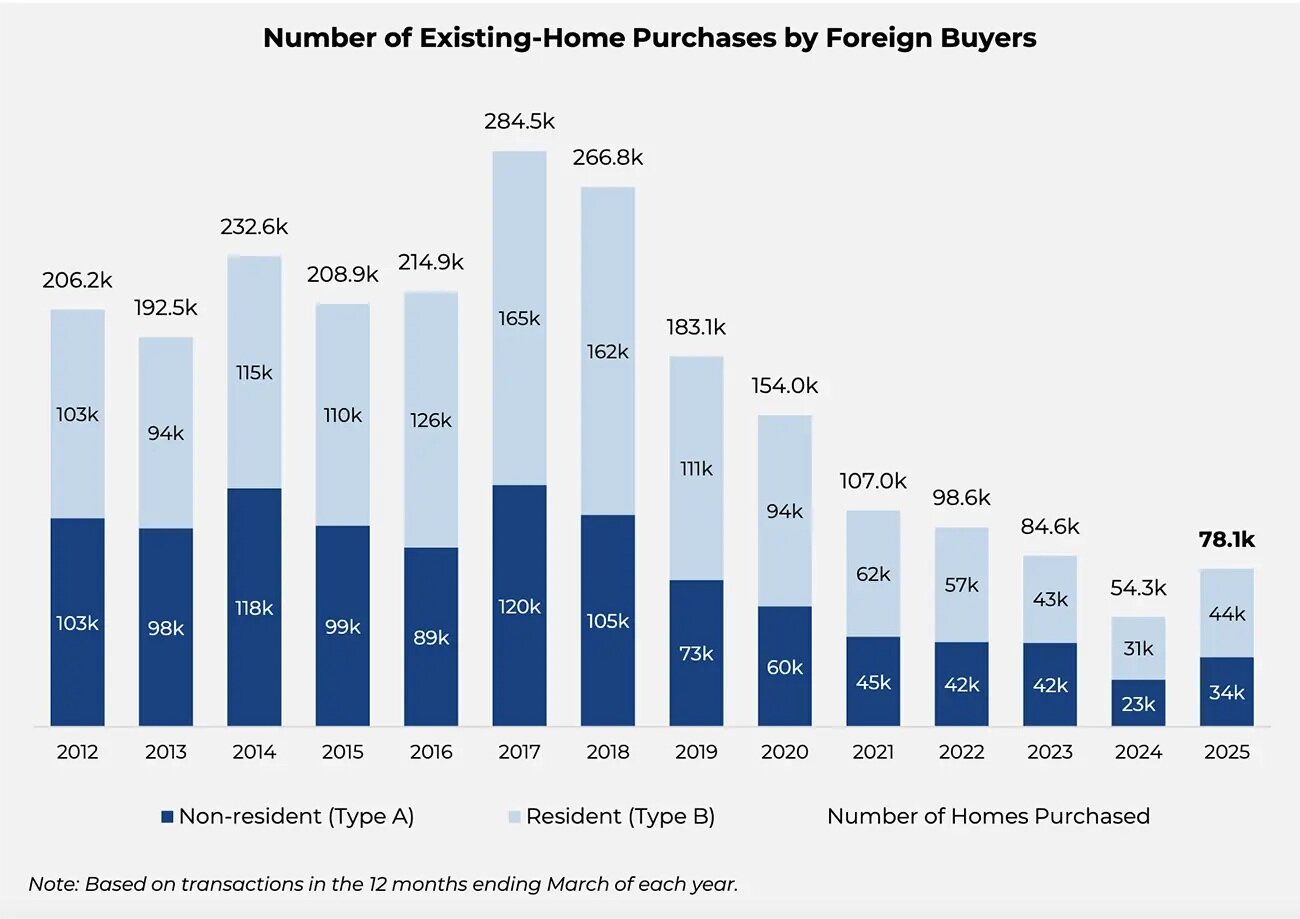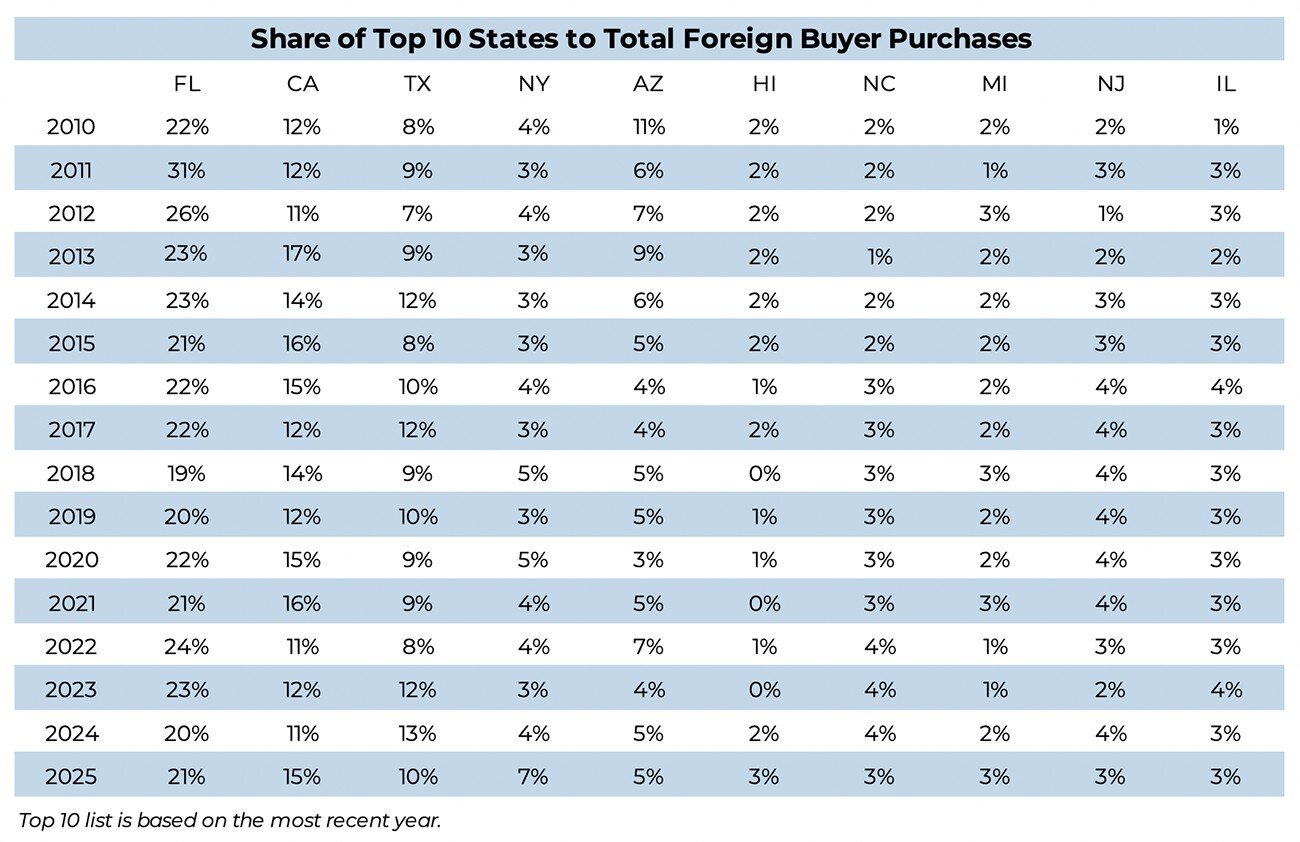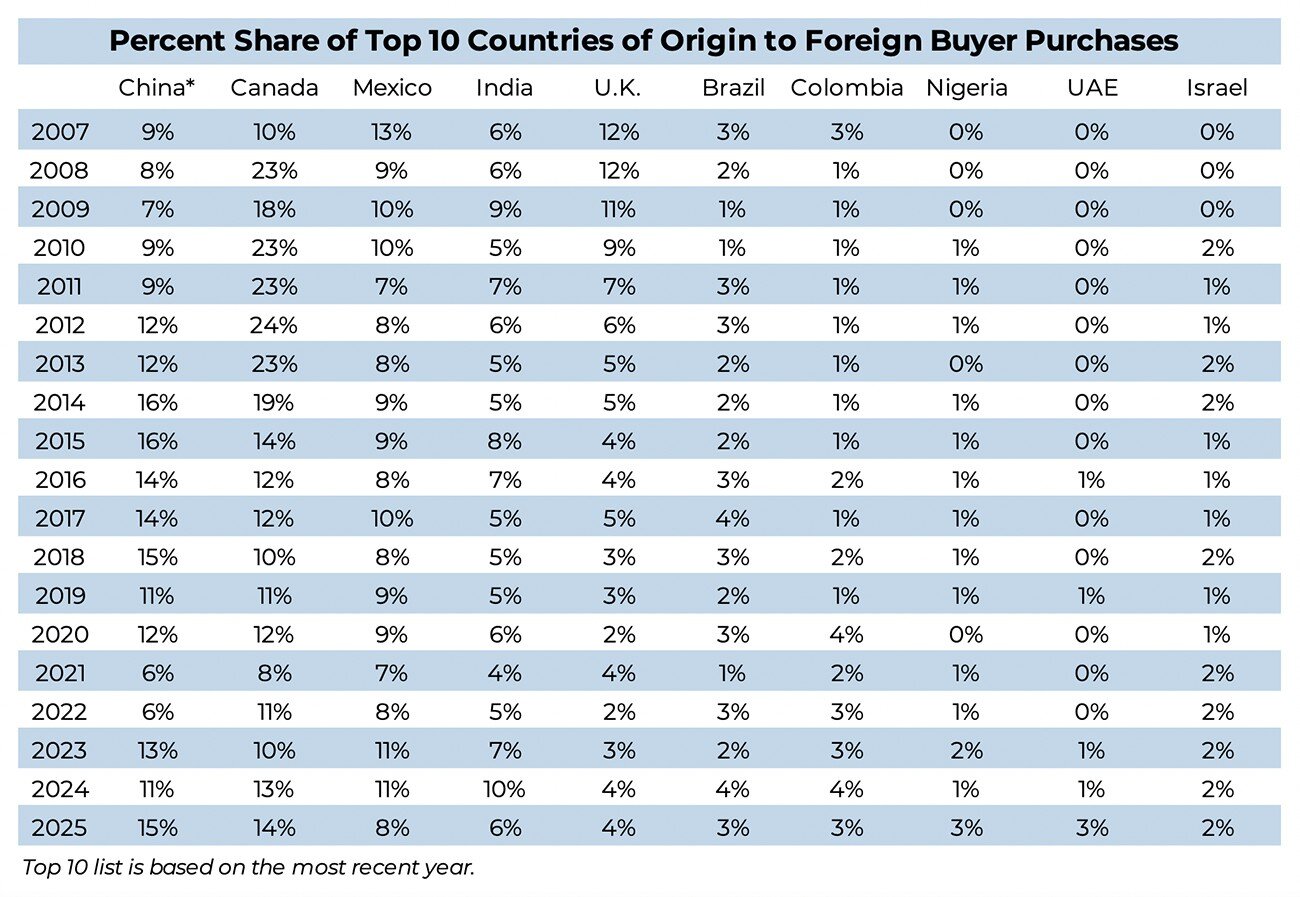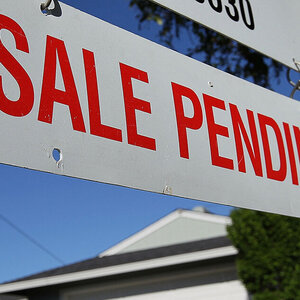Residential Real Estate News

Foreign Investment in U.S. Homes Surges to $56 Billion, Highest Growth Since 2017
Residential News » Laguna Beach Edition | By Michael Gerrity | July 15, 2025 8:44 AM ET
Florida Still Top Destination for International Homebuyers, 15 Years Running
Foreign buyers poured $56 billion into U.S. residential real estate over the past year, snapping a six-year streak of declining interest and signaling a resurgence in global appetite for American housing, according to a new report from the National Association of Realtors (NAR).
From April 2024 to March 2025, international buyers snapped up 78,100 existing homes--a 44% jump from the previous year and the first annual increase in foreign purchases since 2017. The dollar volume rose by more than one-third year-over-year, driven in part by a record median home price of $494,400 paid by overseas investors.
"The post-pandemic global recovery has reenergized demand for U.S. property," said Lawrence Yun, NAR's chief economist. "Still, high home prices and borrowing costs continue to keep total sales activity well below pre-COVID levels."
Foreign investment activity was concentrated in sunbelt states and coastal markets, with Florida once again claiming the top spot for international buyers. The Sunshine State captured 21% of all foreign purchases, extending its streak as the top destination for at least 15 years. California (15%), Texas (10%), New York (7%), and Arizona (5%) followed.
A Return to U.S. Real Estate - With Cash in Hand
Amid a landscape of elevated mortgage rates and tight credit conditions, nearly half of all international buyers--47%--paid entirely in cash, nearly double the share of all domestic buyers. International investors also gravitated toward higher-end properties, further boosting overall price averages.
Buyers from China led the charge, accounting for 15% of all foreign purchases with an estimated $13.7 billion in transaction volume. Canada followed with 14% of deals ($6.2 billion), then Mexico (8%, $4.4 billion), India (6%, $2.2 billion), and the United Kingdom (4%, $2 billion).
Roughly 56% of international buyers were already residing in the U.S. as recent immigrants or visa holders, responsible for $26.9 billion in volume. The remaining 44%--buyers living abroad--accounted for $29.1 billion, a sign that U.S. real estate continues to attract cross-border capital despite geopolitical and macroeconomic headwinds.
Tariffs, Tight Credit, and Global Headwinds
The data, collected before the U.S. announced new tariff policies in April 2025, captures a window of relative economic optimism before escalating trade tensions began to complicate the outlook. While future reports may reflect a cooling effect, the recent surge suggests international investors remain drawn to the U.S. by its legal protections, stable economy, and long-term growth prospects.
"The U.S. stands out globally for the security it offers real estate investors, especially around private property rights," said Yun. "That remains a key driver for foreign capital, particularly in uncertain times."
Despite the rebound, international investment levels are still well below their 2017 peak, when foreign buyers spent over $150 billion on U.S. real estate. Whether this year's resurgence marks the beginning of a sustained recovery or a temporary rebound remains to be seen. But for now, the global market is once again knocking on America's front door.
Sign Up Free | The WPJ Weekly Newsletter
Relevant real estate news.
Actionable market intelligence.
Right to your inbox every week.
Real Estate Listings Showcase
Related News Stories
Residential Real Estate Headlines
- U.S. New-Home Sales Surge in August as Mortgage Rates Ease
- Despite Increased Foreign Buyer Activity, Miami Residential Sales Dip 11 Percent in August
- California Home Sales Enjoy Modest Uptick as Mortgage Rates Ease
- U.S. Home-Flipping Profits Sink to Lowest Level Since 2008 Financial Crisis as Costs Climb
- Why the World's Rich Are Flocking to Europe in 2025
- Federal Reserve Delivers First Rate Cut of 2025 as Mortgage Relief Proves Limited
- Homebuilder Sentiment Holds Steady in U.S. as Rate-Cut Bets Lift Outlook
- U.S. Mortgage Rates Experience Sharpest Weekly Drop in Over a Year
- U.S. Foreclosures Rise for Sixth Straight Month as Affordability Pressures Mount
- Black U.S. Homeownership Rate Falls to Two-Year Low as Job Losses Mount
- Las Vegas Home Prices Flatten as Listings Surge, Sales Slow
- Cooling Miami Housing Market Sees 16 Percent Annual Sales Drop in July
- U.S. Mortgage Delinquencies Uptick in June Amid Regional Pressures
- California, Florida Top U.S. Housing Markets Most at Risk of Downturn
- 30-Year Mortgage Drops to 6.56 Percent in Late August, Lowest Since October 2024
- Investors Maintain Elevated Role in U.S. Housing Market Despite Slight Pullback
- Pending Home Sales Show Mixed Signals as U.S. Buyers Remain Cautious
- Canadian Home Sales Extend Recovery in July
- U.S. Home Sales Rise in July as Buyers Gain More Bargaining Power
- Zombie Foreclosures Edge Up Across U.S.
- 2.6 Million Homes at Wildfire Risk Across 14 Western States in 2025
- One in Five Americans Willing to Trade Personal Safety for Home Affordability
- U.S. Home Price Growth Slows as Affordability Pressures Mount in 2025
- U.S. Mortgage Rates Dip to Four Month Low in Early August
- U.S. Mortgage Applications Rise in Late July, Breaking Four-Week Slump
- Hong Kong's Housing Market Stuck in Stalemate as Bulls and Bears Face Off
- U.S. Condo Market Struggles in 2025
- U.S. Pending Home Sales Remain Sluggish in June
- Los Angeles Area Wildfires Destroyed Nearly $52 Billion in Homes Last January
- Greater Palm Beach Area Residential Sales Slip in June Amid Growing Inventory
- Economic Resilience Lifts U.S. Housing Outlook Going Forward
- New Home Sales Stagnate as Affordability Struggles Continue in America
- U.S. Housing Market Slips in June as Prices Hit New Highs
- Florida, California Continue to Reign Supreme as America's Ultraluxury Housing Markets
- Caribbean Housing Market Evolves into Global Second-Home Hotspot
- U.S. Home Sales See Highest June Cancellation Rate on Record
- Orlando Housing Market Cools in June as Listings Slide, Sales Slow
- Private Credit Surges in 2025 as Real Estate Developers Bypass Banks
- U.S. Condo Market Suffers Sharpest Price Drops in Over a Decade as Buyers Retreat
- Rising Taxes, Insurance Costs Undermine the Stability of U.S. Homeownership










